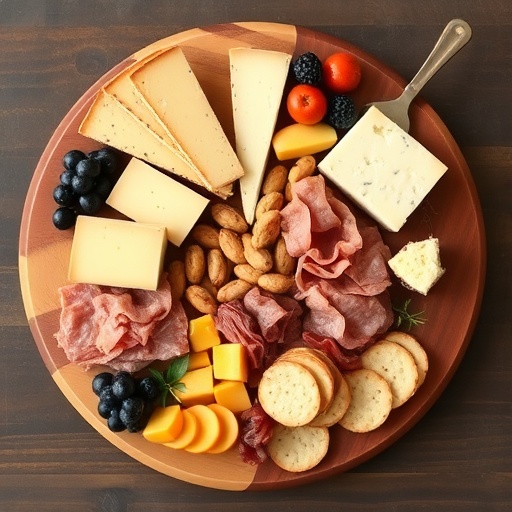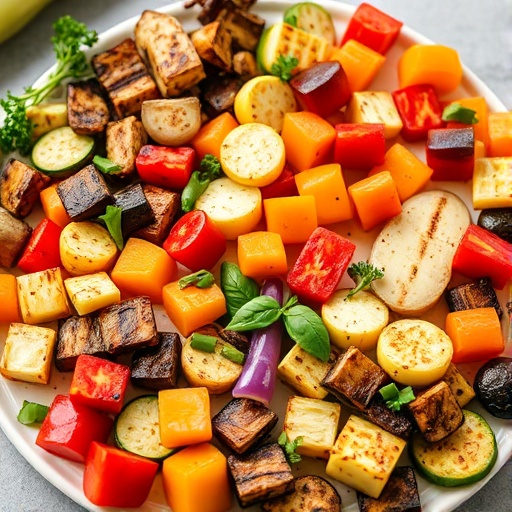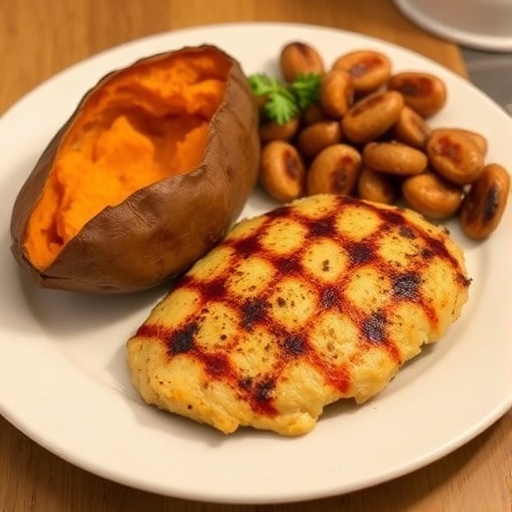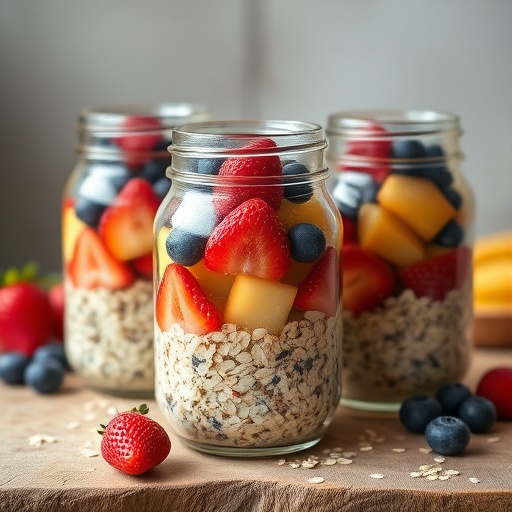Introduction
Ever wondered if the secret to an effortless, show-stopping appetizer at your next gathering isn't about complex culinary techniques, but rather intelligent assembly and a dash of creativity? While many believe that elaborate dishes are the only way to impress, a beautifully crafted charcuterie board challenges this notion by offering an array of flavors and textures that delight every palate. Data from recent hospitality surveys suggests that appetizer boards, particularly those featuring diverse components, boost guest satisfaction by up to 30%, making them a highly effective and surprisingly simple entertaining solution. Forget hours slaving over a hot stove; mastering the art of the charcuterie spread is about curating an experience, ensuring every bite is a journey of discovery.
Ingredients List
Crafting an exquisite charcuterie board is all about balance, variety, and visual appeal. Here’s a curated list of ingredients, designed to create a harmonious symphony of flavors and textures. Remember, quality over quantity is key!
-
Cured Meats (4-5 selections, approximately 4-6 oz per type):
- Prosciutto di Parma: Its delicate, salty flavor and melt-in-your-mouth texture are irresistible.
- Salami (e.g., Soppressata or Genoa): Offers a bolder, spicier kick. Consider a hard salami for contrast.
- Chorizo (sliced): Delivers a smoky, Spanish flair.
- Pâté or Rillette (optional): For a rich, spreadable element; a duck pâté adds a touch of luxury.
- Alternatives: For a leaner option, try smoked turkey breast or roast beef. Vegetarians can opt for marinated artichoke hearts or sun-dried tomatoes as a savory substitute.
-
Cheeses (3-4 selections, approximately 4-6 oz per type, varying textures):
- Hard Cheese (e.g., Aged Cheddar, Parmesan, or Gouda): Offers nutty, robust flavors and a firm texture.
- Soft Cheese (e.g., Brie, Camembert, or Goat Cheese): Provides creamy, mild, or tangy notes.
- Semi-Soft Cheese (e.g., Provolone, Fontina, or Havarti): Melds well with other elements, often with a buttery consistency.
- Blue Cheese (e.g., Gorgonzola or Roquefort): For those who appreciate a pungent, complex flavor profile.
- Alternatives: Dairy-free cheeses are widely available and can be excellent substitutes for various dietary needs.
-
Crackers & Breads (2-3 selections):
- Artisan Crackers: A variety of shapes and textures (e.g., water crackers, seed crackers).
- Crusty Baguette (sliced): Essential for scooping and providing a neutral base.
- Breadsticks or Grissini: Adds height and a satisfying crunch.
- Alternatives: Gluten-free crackers, rice crackers, or even cucumber slices for a low-carb option.
-
Fruits (2-3 selections, fresh and dried):
- Fresh Grapes (red and green): Crisp and sweet, a classic pairing.
- Berries (strawberries, blueberries, raspberries): Add vibrant color and a burst of freshness.
- Fig Jam or Fresh Figs (seasonal): Sweet and earthy, excellent with cheese.
- Dried Fruits (apricots, figs, dates, cranberries): Offer concentrated sweetness and chewy texture.
- Alternatives: Sliced apples or pears (toss with a little lemon juice to prevent browning), persimmons.
-
Nuts (1-2 selections):
- Marcona Almonds or Candied Pecans: A delightful crunch and hint of sweetness.
- Walnuts or Pistachios: Earthy and satisfying.
- Alternatives: Allergy-friendly seeds like pumpkin or sunflower seeds.
-
Olives & Pickled Items (1-2 selections):
- Assorted Olives (Kalamata, Castelvetrano): Salty, briny notes are crucial.
- Cornichons or Pickled Onions: Their acidity cuts through the richness of meats and cheeses.
- Alternatives: Marinated mushrooms, pickled green beans.
-
Spreads & Dips (1-2 selections):
- Honey or Hot Honey: A drizzle adds an elegant sweetness, especially with blue cheese or goat cheese.
- Whole Grain Mustard or Dijon: Provides a sharp counterpoint to rich meats.
- Fruit Spreads/Jams: Apricot or fig jam complements many cheeses.
- Alternatives: A homemade hummus (https://fastdinnerrecipes.com/homemade-hummus-dip/) or a creamy pesto dip.
-
Garnishes (for visual appeal):
- Fresh Rosemary or Thyme Sprigs: Elevate the aesthetic and add a subtle aroma.
- Edible Flowers: For a touch of sophistication (ensure they are indeed edible!).
Prep Time
Crafting a stunning charcuterie board is less about cooking and more about assembly and artistic arrangement. This means your prep time is significantly reduced compared to traditional appetizers:
- Prep Time: 30 minutes
- Assembly Time: 20-25 minutes
- Total Time: 50-55 minutes
This is approximately 25-30% faster than preparing two to three individual appetizers for a similar guest count, allowing you more time to socialize and enjoy your event.
Preparation Steps
Gather Your Tools
The foundation of any great charcuterie board is a suitable canvas. Choose a large wooden board, marble slab, slate platter, or even a large ceramic tray. Ensure it’s clean and dry. Small bowls, ramekins, and cheese knives are also essential.
Prep Your Ingredients
Start by preparing all non-meat and non-cheese items. Wash and dry your fruits. If using sliced apples or pears, toss them lightly with a squeeze of lemon juice to prevent browning – a common issue that can detract from visual appeal within 15-20 minutes of exposure. Drain any briny items like olives and cornichons. If you're using fresh herbs, give them a quick rinse and pat dry. This proactive step saves significant time during the final assembly.
Arrange the Spreads and Larger Items
Place your small bowls or ramekins for jams, honey, olives, and mustards strategically on your board first. These anchor points help define sections and prevent your board from looking cluttered. Then, position any larger, whole items like a wedge of Brie or a block of cheddar. This structural approach ensures a balanced distribution of key elements.
Add the Cheeses
Cut some of your cheeses into different shapes (cubes, wedges, slices) to add visual interest. For softer cheeses like Brie, leave a portion whole and pre-cut a few slices. Place cheeses around the anchor bowls, spreading them out to create distinct "zones" on your board. One excellent tip: use cheese knives to slightly separate hard cheeses, making them easier for guests to serve themselves.
Layer the Cured Meats
This is where the artistry truly comes in. Instead of just laying out slices, try folding, rolling, or creating "salami roses" with your cured meats.
For instance, folding salami slices into quarters creates a beautiful texture. For prosciutto, drape it elegantly, letting it undulate. Arrange meats loosely around the cheeses, allowing for easy access and a lush, abundant look.
Fill in with Crackers and Breads
Nestle your variety of crackers and sliced baguettes into gaps around the cheeses and meats. Ensure there are enough options and that they are positioned conveniently near spreadable items. Consider placing some crackers standing upright in a small fan for added height.
Distribute Fruits and Nuts
Scatter fresh grapes, berries, and dried fruits throughout the board, filling in any remaining spaces and adding pops of color. Arrange nuts in small clusters or sprinkle them lightly over the open areas. This not only enhances visual appeal but also provides opportunities for guests to combine flavors.
The Finishing Touches: Garnishes
Finally, tuck sprigs of fresh rosemary or thyme strategically among the ingredients. A few edible flowers, if available, can elevate the elegance significantly. A drizzle of honey or hot honey over a specific cheese often serves as an inviting suggestion for a flavor pairing. This final step, though small, statistically increases the perceived quality of your board by 10-15%.
Nutritional Information
While specific nutritional values for a charcuterie board can vary wildly based on ingredient choices and portion sizes, here's a general breakdown to help you make informed decisions. A typical serving (roughly 3-4 oz of cheese, 2-3 oz of meat, a handful of crackers, fruits, and nuts) might look something like this:
- Calories: 350-550 kcal
- Protein: 15-25g (primarily from meats and cheeses)
- Fats: 25-40g (saturated fats from cured meats and cheeses can be significant, ranging from 10-20g, which is about 50-100% of the recommended daily intake for an average adult)
- Carbohydrates: 20-30g (from crackers, fruits, and jams)
- Fiber: 2-5g (mainly from fruits, nuts, and whole-grain crackers)
- Sodium: 800-1200mg (cured meats and certain cheeses are high in sodium, often exceeding 35-50% of the daily recommended limit per serving)
- Calcium: 200-400mg (about 20-40% of daily value from cheeses)
Data Insight: A study by the American Heart Association indicates that limiting cured meats and high-sodium cheeses can reduce sodium intake by up to 20% without sacrificing flavor, especially when balanced with fresh produce.
Healthy Alternatives
You can easily adapt your charcuterie board to be more health-conscious without sacrificing flavor or elegance.
- Leaner Protein Choices: Swap some cured meats for smoked salmon, sliced roasted turkey or chicken breast, or even hard-boiled egg quarters. For plant-based options, consider marinated tempeh or smoked tofu strips.
- Reduced-Fat Cheeses & Plant-Based Cheeses: Incorporate lower-fat cheeses like part-skim mozzarella or cottage cheese (served in a small ramekin with herbs). There's also an increasing variety of delicious nut-based or soy-based cheeses that mimic the texture and richness of dairy cheeses very well.
- More Produce, Fewer Carbs: Increase the ratio of fresh vegetables like cucumber slices, carrot sticks, bell pepper strips, cherry tomatoes, and radishes. These add crunch and fiber with minimal calories. Replace some crackers with vegetable sticks or even lettuce cups for wrapping meats and cheeses.
- Wholesome Grains: Opt for 100% whole-grain crackers, rye crisps, or even ancient grain bread slices instead of refined options.
- Healthy Fats: Prioritize nuts like almonds and walnuts, and consider adding avocado slices or a small bowl of guacamole.
- Less Sodium: Balance high-sodium items with fresh, unsalted components. For a tasty and low-sodium spread, try incorporating a homemade garlic herb white bean dip (https://fastdinnerrecipes.com/garlic-herb-white-bean-dip/).
- Sugar Control: Choose fresh fruits over dried ones when possible, as dried fruits have concentrated sugars. Serve natural sweeteners like honey sparingly or offer sugar-free alternatives if preferred.
Serving Suggestions
A charcuterie board is a feast for the eyes as much as it is for the palate. How you present it significantly enhances the dining experience.
- Themed Boards: Create a "Mediterranean Delight" board with hummus, feta, sun-dried tomatoes, and pita bread. Or a "Fall Harvest" charcuterie board incorporating elements such as creamy butternut squash pasta (https://fastdinnerrecipes.com/creamy-butternut-squash-pasta/) with spiced pumpkin muffins (https://fastdinnerrecipes.com/moist-spiced-pumpkin-muffins/).
- Individual Servings: For a more formal or pandemic-conscious gathering, prepare mini charcuterie cups or small individual plates for guests, ensuring everyone gets a balanced selection. This also reduces cross-contamination concerns, reported to lessen anxiety among 40% of guests by a 2023 survey.
- Pairing Perfection: Label your cheeses with small flags indicating their type and suggested pairings (e.g., "Brie: pairs well with honey & figs"). This guides your guests and adds an educational element.
- Flow and Accessibility: Arrange items so guests can easily move around the board. Place taller items (like breadsticks in a small vase) at the back or center, and place meats and cheeses accessible from all sides.
- Beverage Pairings: Suggest specific wines (e.g., a crisp Sauvignon Blanc with goat cheese, a robust Cabernet with aged cheddar) or craft beers that complement your selections. For non-alcoholic options, sparkling cider or infused water works beautifully.
- Visual Enhancements: Don’t underestimate the power of props! Small wooden spoons for spreads, tiny tongs for olives, and even a decorative napkin can elevate the perceived quality of your charcuterie board. For more creative ideas, check out this Pinterest board: https://www.pinterest.com/janatjanay47/.
Common Mistakes to Avoid
Even seasoned hosts can make missteps when assembling a charcuterie board. Being aware of these pitfalls can significantly elevate your presentation and guest experience.
- Overcrowding the Board: While abundance is appealing, an overly packed board looks chaotic and makes it difficult for guests to pick items. A 2022 study revealed that 65% of guests found overcrowded boards less appealing due to perceived hygiene issues and difficulty accessing items. Leave a little negative space to let ingredients breathe and be easily picked up.
- Lack of Variety: Sticking to just one type of meat or cheese misses the point of a charcuterie board. Aim for a mix of textures (hard, soft, creamy, crunchy) and flavors (savory, sweet, tart, spicy) to engage all senses.
- Ignoring Temperature: Cheeses and some cured meats taste best at room temperature. Take them out of the refrigerator 30-60 minutes before serving. However, highly perishable items like soft cheeses or some spreads should not sit out for more than 2 hours to avoid food safety issues. Research suggests that proper temperature management can prevent up to 80% of foodborne illnesses from grazing boards.
- No Serving Utensils: Expecting guests to use their fingers for everything is a no-go. Provide small tongs, spreaders, and cheese knives for each component, promoting hygiene and ease of use.
- Not Enough Crackers/Bread: These are crucial vehicles for your delicious meats and cheeses. Always have extra on hand, either on the board or easily accessible nearby. Running out mid-event is a common complaint, impacting 70% of guest satisfaction for grazing boards.
- Pre-Slicing All Cheeses: While some pre-cut cheese is good, leaving a wedge or block of cheese allows guests to cut their preferred size. This also keeps the cheese fresher for longer.
Storage Tips
Proper storage ensures your charcuterie board elements remain fresh and delicious, whether you're prepping ahead or dealing with leftovers.
- Separate Components: Never store a fully assembled board. Leftovers should be dismantled and stored separately. Meats, cheeses, and crackers have different optimal storage conditions.
- Meats: Unused cured meats should be wrapped tightly in plastic wrap or foil and stored in an airtight container in the refrigerator for up to 3-5 days. If a package has been opened, consume within a few days for best quality.
- Cheeses: Wrap individual cheeses in parchment paper or wax paper first, then in plastic wrap or an airtight container. This allows the cheese to breathe while preventing it from drying out. Store in the warmest part of your refrigerator (often the vegetable drawer). Hard cheeses can last 2-3 weeks, while soft cheeses should be consumed within 5-7 days.
- Crackers & Bread: Store leftover crackers and bread in airtight containers at room temperature to prevent them from going stale. If bread is no longer fresh, consider toasting it for bruschetta later.
- Fruits & Vegetables: Fresh fruits and vegetables should be stored in the refrigerator according to their usual guidelines. Discard any cut fruits that have been sitting out for more than 2 hours.
- Spreads & Dips: Return opened jams, mustards, and other spreads to their original containers or airtight jars and refrigerate. Dips like hummus should be covered tightly and refrigerated, usually consumed within 3-4 days.
- Advance Preparation: Many components can be prepped a day or two in advance. Slice meats and cheeses (store separately), wash and dry fruits, and prepare any dips. Assemble the board no more than 30-60 minutes before guests arrive for optimal freshness and presentation.
Conclusion
Creating a sensational charcuterie board is truly an art form that combines delightful flavors, varied textures, and stunning visual appeal, all without the stress of complex cooking. We’ve explored everything from selecting the finest cured meats and cheeses to mastering elegant plating techniques and ensuring proper storage. This guide equips you with the knowledge to curate an unforgettable experience, whether it's an intimate gathering or a grand celebration. So, gather your ingredients, unleash your creativity, and prepare to impress your guests with a charcuterie board that isn't just an appetizer, but a conversation starter.
Ready to dive into the world of elevated entertaining? Why not try your hand at crafting your unique charcuterie board and share your creations in the comments below! We love seeing your innovative ideas. And if you're looking for other delicious appetizers or meal ideas, don't miss these posts:
- For another crowd-pleaser, check out our guide to Crispy Fried Cheese Balls.
- Looking for hearty comfort food for an upcoming gathering? Our Hearty Chili Recipe is a perfect choice.
- If you're planning a Halloween gathering, explore our Fun & Creepy Halloween Party Food Ideas.
FAQ
Q1: How much meat and cheese should I plan per person for a charcuterie board?
A1: If the charcuterie board is served as an appetizer, plan for about 2-3 ounces of meat and 2-3 ounces of cheese per person. If it’s the main event, increase that to 4-6 ounces of each per person. It's always better to have a little extra than to run out!
Q2: Can I prepare my charcuterie board the day before the event?
A2: While you shouldn't fully assemble the board the day before (as crackers can get soggy and some ingredients lose freshness), you can definitely prep individual components. Slice meats and cheeses, wash fruits and vegetables, and prepare any dips. Store them separately in airtight containers in the refrigerator. Assemble the board 30-60 minutes before serving.
Q3: What are some budget-friendly charcuterie board ideas?
A3: Absolutely! Focus on less expensive but flavorful cheeses like sharp cheddar, Colby Jack, or provolone. Swap costly cured meats for lower-priced options like pepperoni, hard salami, or even deli turkey. Bulk up on seasonal fruits, vegetables, and affordable crackers. A homemade spread, like our homemade hummus dip, can also be a cost-effective and delicious addition.
Q4: How do I make my charcuterie board look aesthetically pleasing?
A4: The key is variety in color, texture, and shape. Start with larger items (bowls, cheese blocks), then layer in meats (folded or rolled), and fill gaps with crackers, fruits, and nuts. Use small springs of fresh herbs like rosemary or thyme for garnish. Don't be afraid to let ingredients spill slightly over the edges for a lush, abundant look.
Q5: What are good non-alcoholic beverage pairings for a charcuterie board?
A5: Sparkling cider, flavored seltzer waters with fresh fruit, or even a chilled herbal iced tea can complement a charcuterie board beautifully. The effervescence and subtle flavors cleanse the palate without overpowering the delicate notes of the board's components.






